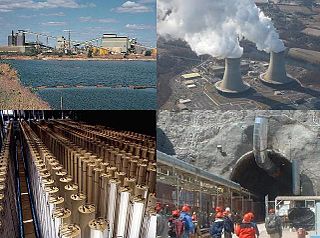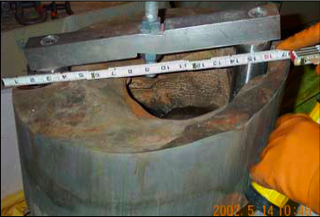Related Research Articles

A boiling water reactor (BWR) is a type of light water nuclear reactor used for the generation of electrical power. It is the second most common type of electricity-generating nuclear reactor after the pressurized water reactor (PWR), which is also a type of light water nuclear reactor. The main difference between a BWR and PWR is that in a BWR, the reactor core heats water, which turns to steam and then drives a steam turbine. In a PWR, the reactor core heats water, which does not boil. This hot water then exchanges heat with a lower pressure system, which turns water into steam that drives the turbine. The BWR was developed by the Argonne National Laboratory and General Electric (GE) in the mid-1950s. The main present manufacturer is GE Hitachi Nuclear Energy, which specializes in the design and construction of this type of reactor.

A nuclear and radiation accident is defined by the International Atomic Energy Agency (IAEA) as "an event that has led to significant consequences to people, the environment or the facility. Examples include lethal effects to individuals, large radioactivity release to the environment, reactor core melt." The prime example of a "major nuclear accident" is one in which a reactor core is damaged and significant amounts of radioactive isotopes are released, such as in the Chernobyl disaster in 1986 and Fukushima nuclear disaster in 2011.

The Browns Ferry Nuclear Plant is located on the Tennessee River near Decatur and Athens, Alabama, on the north side of Wheeler Lake. The site has three General Electric boiling water reactor (BWR) nuclear generating units and is owned entirely by the Tennessee Valley Authority (TVA). With a generating capacity of nearly 3.8 gigawatts, it is the second most powerful nuclear plant in the United States, behind the Palo Verde Nuclear Generating Station in Arizona, and the most powerful generating station operated by TVA.
Probabilistic risk assessment (PRA) is a systematic and comprehensive methodology to evaluate risks associated with a complex engineered technological entity or the effects of stressors on the environment.

A containment building is a reinforced steel, concrete or lead structure enclosing a nuclear reactor. It is designed, in any emergency, to contain the escape of radioactive steam or gas to a maximum pressure in the range of 275 to 550 kPa. The containment is the fourth and final barrier to radioactive release, the first being the fuel ceramic itself, the second being the metal fuel cladding tubes, the third being the reactor vessel and coolant system.
WASH-1400, 'The Reactor Safety Study', was a report produced in 1975 for the Nuclear Regulatory Commission by a committee of specialists under Professor Norman Rasmussen. It "generated a storm of criticism in the years following its release". In the years immediately after its release, WASH-1400 was followed by a number of reports that either peer reviewed its methodology or offered their own judgments about probabilities and consequences of various events at commercial reactors. In at least a few instances, some offered critiques of the study's assumptions, methodology, calculations, peer review procedures, and objectivity. A succession of reports, including NUREG-1150, the State-of-the-Art Reactor Consequence Analyses and others, have carried-on the tradition of PRA and its application to commercial power plants.

The advanced boiling water reactor (ABWR) is a Generation III boiling water reactor. The ABWR is currently offered by GE Hitachi Nuclear Energy (GEH) and Toshiba. The ABWR generates electrical power by using steam to power a turbine connected to a generator; the steam is boiled from water using heat generated by fission reactions within nuclear fuel. Kashiwazaki-Kariwa unit 6 is considered the first Generation III reactor in the world.
NUREG-1150 "Severe Accident Risks: An Assessment for Five U.S. Nuclear Power Plants", published December 1990 by the Nuclear Regulatory Commission (NRC) is a follow-up to the WASH-1400 and CRAC-II safety studies that employs the methodology of plant-specific Probabilistic Risk Assessment (PRA). The research team, led by Denwood Ross, Joseph Murphy, and Mark Cunningham, concluded that the current generation of nuclear power plants exceeded NRC safety goals.

The Economic Simplified Boiling Water Reactor (ESBWR) is a passively safe generation III+ reactor design derived from its predecessor, the Simplified Boiling Water Reactor (SBWR) and from the Advanced Boiling Water Reactor (ABWR). All are designs by GE Hitachi Nuclear Energy (GEH), and are based on previous Boiling Water Reactor designs.

Nuclear safety is defined by the International Atomic Energy Agency (IAEA) as "The achievement of proper operating conditions, prevention of accidents or mitigation of accident consequences, resulting in protection of workers, the public and the environment from undue radiation hazards". The IAEA defines nuclear security as "The prevention and detection of and response to, theft, sabotage, unauthorized access, illegal transfer or other malicious acts involving nuclear materials, other radioactive substances or their associated facilities".

Nuclear safety in the United States is governed by federal regulations issued by the Nuclear Regulatory Commission (NRC). The NRC regulates all nuclear plants and materials in the United States except for nuclear plants and materials controlled by the U.S. government, as well those powering naval vessels.
International Reactor Innovative and Secure (IRIS) is a Generation IV reactor design made by an international team of companies, laboratories, and universities and coordinated by Westinghouse. IRIS is hoped to open up new markets for nuclear power and make a bridge from Generation III reactor to Generation IV reactor technology. The design is not yet specific to reactor power output. Notably, a 335 MW output has been proposed, but it could be tweaked to be as low as a 100 MW unit.

The Fukushima Daiichi Nuclear Power Plant is a disabled nuclear power plant located on a 3.5-square-kilometre (860-acre) site in the towns of Ōkuma and Futaba in Fukushima Prefecture, Japan. The plant suffered major damage from the magnitude 9.0 earthquake and tsunami that hit Japan on March 11, 2011. The chain of events caused radiation leaks and permanently damaged several reactors, making them impossible to restart. By political decision, the remaining reactors were not restarted.

The environmental impact of nuclear power results from the nuclear fuel cycle, operation, and the effects of nuclear accidents.

The United States Government Accountability Office reported more than 150 incidents from 2001 to 2006 of nuclear plants not performing within acceptable safety guidelines. According to a 2010 survey of energy accidents, there have been at least 56 accidents at nuclear reactors in the United States. The most serious of these was the Three Mile Island accident in 1979. Davis-Besse Nuclear Power Plant has been the source of two of the top five most dangerous nuclear incidents in the United States since 1979. Relatively few accidents have involved fatalities.

The Fukushima nuclear disaster was a 2011 nuclear accident at the Fukushima Daiichi Nuclear Power Plant in Ōkuma, Fukushima, Japan. The proximate cause of the disaster was the 2011 Tōhoku earthquake and tsunami that occurred 11 March 2011.

The Fukushima Daiichi nuclear disaster was a series of equipment failures, nuclear meltdowns, and releases of radioactive materials at the Fukushima I Nuclear Power Plant, following the Tōhoku earthquake and tsunami on 11 March 2011. It is the largest nuclear disaster since the Chernobyl disaster of 1986.

Unit 3 of the Fukushima Daiichi Nuclear Power Plant was one of the reactors in operation on 11 March 2011, when the plant was struck by the tsunami produced by the Tohoku earthquake. In the aftermath, the reactor experienced hydrogen gas explosions and suffered a partial meltdown, along with the other two reactors in operation at the time the tsunami struck, unit 1 and unit 2. Efforts to remove debris and coolant water contaminated with radiation are ongoing and expected to last several decades.

The Fukushima Daiichi nuclear accident was a series of equipment failures, nuclear meltdowns, and releases of radioactive materials at the Fukushima I Nuclear Power Plant, following the Tōhoku earthquake and tsunami on 11 March 2011. It was the largest nuclear disaster since the Chernobyl disaster of 1986, and the radiation released exceeded official safety guidelines. Despite this, there were no deaths caused by acute radiation syndrome. Given the uncertain health effects of low-dose radiation, cancer deaths cannot be ruled out. However, studies by the World Health Organisation and Tokyo University have shown that no discernible increase in the rate of cancer deaths is expected. Predicted future cancer deaths due to accumulated radiation exposures in the population living near Fukushima have ranged in the academic literature from none to hundreds.

The Fukushima Daiichi nuclear disaster was a series of equipment failures, nuclear meltdowns, and releases of radioactive materials at the Fukushima I Nuclear Power Plant, following the Tōhoku earthquake and tsunami on 11 March 2011. It is the largest nuclear disaster since the Chernobyl disaster of 1986.
References
- ↑ "Glossary -- Core Damage Frequency". Washington, DC: Nuclear Regulatory Commission . Retrieved 2008-11-29.
- ↑ "Definition of PRA". Probabilistic Risk Assessment (PRA). Washington, DC: Nuclear Regulatory Commission. November 28, 2007. Retrieved 2008-09-12.
- 1 2 3 4 Leurs, BA; R.C.N. Wit (January 2003). "Environmentally Harmful Support Measures in EU Member States" (PDF). CE, Publication number 03.7905.11: 137. Archived from the original (PDF) on 2012-10-27. Retrieved 2012-06-13.
{{cite journal}}: Cite journal requires|journal=(help) - 1 2 Curtis L. Smith (1998). "Calculating Conditional Core Damage Probabilities for Nuclear Power Plant Operations" (PDF). Idaho Falls, Idaho: Idaho National Engineering and Environmental Laboratory. Archived from the original (PDF) on 2008-08-28. Retrieved 2008-11-29.
- ↑ Gaertner, John; Ken Canavan; Doug True (February 2008). "Safety and Operational Benefits of Risk-Informed Initiatives" (PDF). Electric Power Research Institute: 3 footnote 3. Retrieved 2008-09-12.
{{cite journal}}: Cite journal requires|journal=(help) - ↑ Thomas B. Cochran (April 27, 2011). "Reassessing the frequency of partial core melt accidents". National Resources Defense Council. Archived from the original on May 8, 2012. Retrieved June 19, 2011.
- ↑ James M. Acton and Mark Hibbs (March 2012). "Why Fukushima Was Preventable" (PDF). Carnegie Endowment for International Peace. Archived from the original on 2016-11-02. Retrieved 2016-09-04.
- ↑ Susan Dingman (1995). "Core damage frequency perspectives for BWR 3/4 and Westinghouse 4-loop plants based on IPE results" (PDF). US NRC.